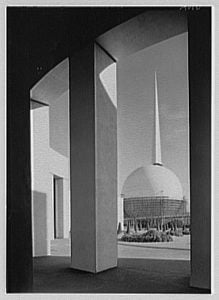1939: Economic Depression and The World of Tomorrow
A group of concerned business leaders conceived of the 1939/1940 World’s Fair in 1935, just six years after the stock market crash that precipitated a global economic crisis. Over ten million Americans found themselves unemployed and unable to support their families. Economic depression further bred emotional depression. New York appeared a particularly bleak place.

View of the 1939 theme buildings, The Trylon and Perisphere by Samuel Gottscho, 1939.
Given the state of the city, a group of financial and commercial leaders looked for ways to boost both the economy and city morale. After studying the astounding commercial and popular success of fairs like Chicago’s 1933 “Century of Progress,” prominent businessmen like Grover Whalen thought that a New York World’s Fair might help to revive the city.
In their view, a well–designed fair would not only create jobs, but would also show visitors a brighter future and fend off more radical social critiques. This idea formed the basis for the fair’s theme: “The World of Tomorrow.” In focusing on the future, fair planners sought to highlight the ways in which new technology could alleviate the human workload. In 1939, the ‘World of Tomorrow’ was filled with industrial tools that increased productivity, created jobs, and minimized physical labor.
With a theme in place, the fair moved forward under the direction of a man singularly devoted to New York: Grover Whalen.